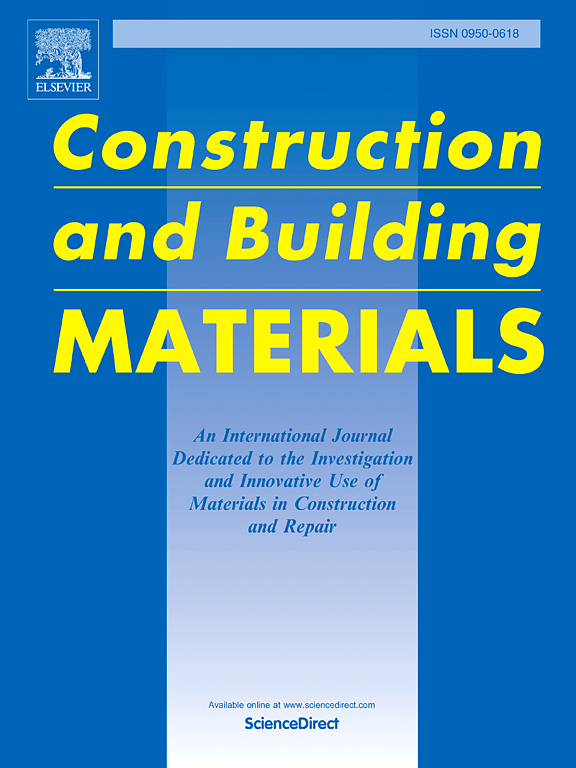Magneto-rheological effect of cement paste containing graphene nano-platelets and Fe3O4 particles
IF 8
1区 工程技术
Q1 CONSTRUCTION & BUILDING TECHNOLOGY
引用次数: 0
Abstract
This experimental investigation focused on controlling the orientation of graphene nano-platelets (GNPs) within the cementitious matrix potentially to enhance the mechanical and self-sensing properties, utilizing magnetite particles (MPs) and a magnetic field. For this purpose, the optimal dispersion methods, i.e., 30-min ultrasonication for GNPs and high-shear mixing for MPs were identified. A series of flow table tests was then conducted to examine the magneto-rheological response of cement pastes containing varying concentrations of GNPs (0.02 % - 0.08 %) and 5 % of MPs with varying water-to-cement (w/c) ratios of 0.4–0.47. Moreover, hardened samples for compression tests were prepared by applying the magnetic field from two directions to investigate the GNPs-MPs alignment effect. Cement paste containing GNPs and MPs significantly reduced flowability over time under a magnetic field, especially at a lower w/c ratio of 0.4. This is due to the alignment and formation of chains of GNP-MPs under a magnetic field. From 1-day compression results, it was found that 30 min of magnetic field application improved hydration, possibly by the magnetization of water. The orientation of the magnetic field also influenced compressive strength, with vertical alignment to the field likely promoting better load distribution and hydration dynamics, leading to a 97.22 % increase in compressive strength with 0.08 % GNPs and 5 % MPs incorporation. The XRD analysis confirmed elevated portlandite and C-S-H peaks in magnetized samples, demonstrating the effect of a magnetic field on cement hydration.
含石墨烯纳米薄片和Fe3O4颗粒水泥浆体的磁流变效应
本实验研究的重点是利用磁铁矿颗粒(MPs)和磁场控制胶凝基质中石墨烯纳米薄片(GNPs)的取向,以潜在地增强其机械和自传感性能。为此,确定了GNPs的最佳分散方法为超声30 min, MPs的最佳分散方法为高剪切混合。然后进行了一系列流动表试验,以检查水灰比(w/c)为0.4-0.47时,含有不同浓度GNPs(0.02 % - 0.08 %)和5 % MPs的水泥浆体的磁流变响应。在两个方向的磁场作用下,制备了用于压缩试验的硬化样品,以研究GNPs-MPs的排列效应。随着时间的推移,含有GNPs和MPs的水泥浆在磁场作用下的流动性会显著降低,尤其是在w/c比为0.4的情况下。这是由于磁场作用下GNP-MPs链的排列和形成。从1天的压缩结果来看,30 min的磁场作用可以改善水化作用,可能是由于水的磁化作用。磁场的方向也会影响抗压强度,与磁场垂直对齐可能会促进更好的载荷分布和水化动力学,导致抗压强度增加97.22% %,GNPs掺入0.08 %,MPs掺入5% %。XRD分析证实磁化后的样品中硅酸盐和C-S-H峰升高,表明磁场对水泥水化的影响。
本文章由计算机程序翻译,如有差异,请以英文原文为准。
求助全文
约1分钟内获得全文
求助全文
来源期刊

Construction and Building Materials
工程技术-材料科学:综合
CiteScore
13.80
自引率
21.60%
发文量
3632
审稿时长
82 days
期刊介绍:
Construction and Building Materials offers an international platform for sharing innovative and original research and development in the realm of construction and building materials, along with their practical applications in new projects and repair practices. The journal publishes a diverse array of pioneering research and application papers, detailing laboratory investigations and, to a limited extent, numerical analyses or reports on full-scale projects. Multi-part papers are discouraged.
Additionally, Construction and Building Materials features comprehensive case studies and insightful review articles that contribute to new insights in the field. Our focus is on papers related to construction materials, excluding those on structural engineering, geotechnics, and unbound highway layers. Covered materials and technologies encompass cement, concrete reinforcement, bricks and mortars, additives, corrosion technology, ceramics, timber, steel, polymers, glass fibers, recycled materials, bamboo, rammed earth, non-conventional building materials, bituminous materials, and applications in railway materials.
 求助内容:
求助内容: 应助结果提醒方式:
应助结果提醒方式:


